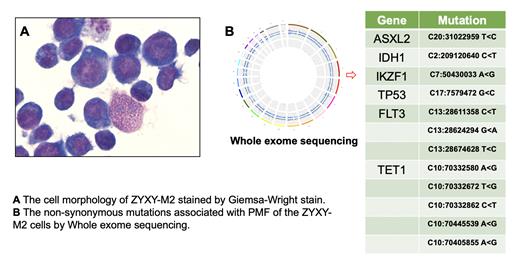Abstract
Aims: Primary myelofibrosis (PMF) is a myeloproliferative neoplasm (MPN) characterized by clonal proliferation of stem cells and myeloid cells. JAK2, CARL, and MPL mutations could be detected in most patients, but 15% of PMF patients could be absent of these three gene mutations. PMF has shorter median survival time and poorer prognosis when compared with closely related MPNs, polycythemia vera (PV) and essential thrombocythemia (ET). Allogenic hematopoietic stem cells (allo-HSCT) is the only curative therapy for PMF patients, however transplantation-related complications and deaths were observed in more than 50% patients. Hydroxyurea and Ruxolitinib are commonly used drugs to improve clinical symptoms of PMF patients, but lack of anti-tumor activities. These drugs could not reverse bone marrow fibrosis or induce cytogenetic remission. Basic research work of PMF is limited as to the lack of human PMF cell line. Here, we aimed to establish and characterize a patient-derived human PMF cell line, which would provide a useful tool for PMF research and screenings for novel drugs.
Methods: The bone marrow cells were obtained from a 61-year-old male patient, who was diagnosed as PMF for 2 years. Mono-nuclear cells were isolated and cultured in a continuous culture system. The cells were characterized by different methods, including STR profiling, morphology observation with Giemsa staining, flow cytometry, chromosome analysis, Epstein-Barr virus (EBV) detection, mycoplasma detection, whole-genome-exon sequencing, and cell proliferation assay.
Results: The cells have continued to grow in liquid culture for more than 50 passages using the same culture conditions. Doubling time was about 48-72 hours. The STR profiling identified that the cultured cells and the patient's bone marrow cells were from the same origin. The cells are free from EBV and mycoplasma. Giemsa-Wrights staining showed primitive erythrocytes (Figure A), which was consistent with CD71 positive detected by flow cytometry. Chromosome analysis revealed a hyperdiploid karyotype, which was 47, XY,+12[1]/48,idem,+9[9]. Whole-genome-exon sequencing identified mutations of ASXL1, TP53, IKZF1, IDH1, FLT3, and TET1 (Figure B). Now this cell line, designated ZYXY-M2, is collected by China center for type culture collection (CCTCC).
Discussion: Established cell lines are invaluable tools in cell biology. Right now, HEL and SET-2 are two cell lines that are most widely used in MPN-related researches. HEL is an erythroleukemia cell line which was derived from a patient with leukemia transformation of Hodgkin's disease, and SET-2 is a megakaryoblastic cell line which was derived from a patient with leukemic transformation of ET. Here, we established a cell line, ZYXY-M2, derived from a PMF patient and it would prove to be a valuable model for the study of PMF. ZYXY-M2 could help to explore the pathogenesis and development of PMF, novel drug screening, and may also help to set up xenograft PMF mouse models.
No relevant conflicts of interest to declare.


This feature is available to Subscribers Only
Sign In or Create an Account Close Modal